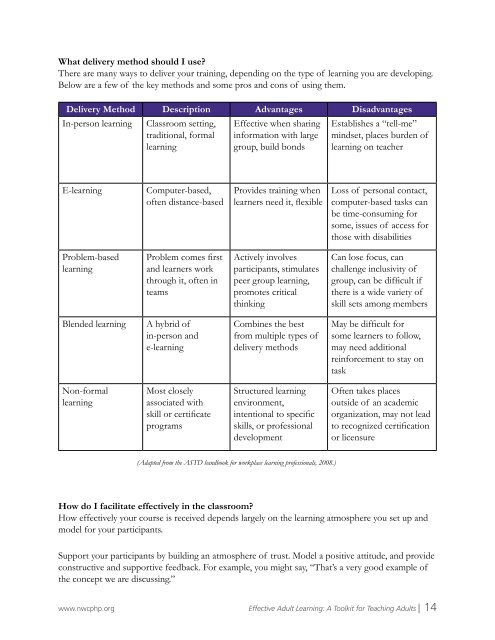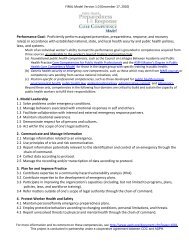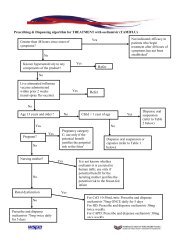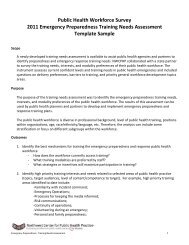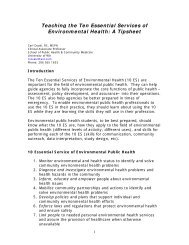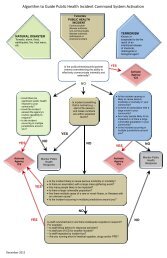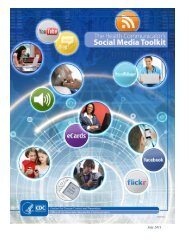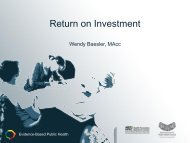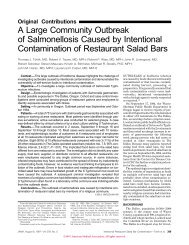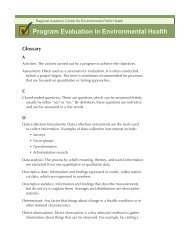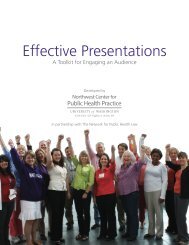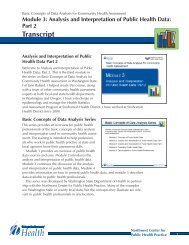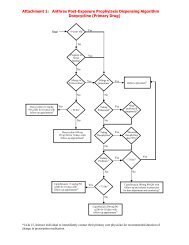Effective Adult Learning - Northwest Center for Public Health Practice
Effective Adult Learning - Northwest Center for Public Health Practice
Effective Adult Learning - Northwest Center for Public Health Practice
Create successful ePaper yourself
Turn your PDF publications into a flip-book with our unique Google optimized e-Paper software.
What delivery method should I use?<br />
There are many ways to deliver your training, depending on the type of learning you are developing.<br />
Below are a few of the key methods and some pros and cons of using them.<br />
Delivery Method Description Advantages Disadvantages<br />
In-person learning Classroom setting,<br />
traditional, <strong>for</strong>mal<br />
learning<br />
<strong>Effective</strong> when sharing<br />
in<strong>for</strong>mation with large<br />
group, build bonds<br />
Establishes a “tell-me”<br />
mindset, places burden of<br />
learning on teacher<br />
E-learning<br />
Computer-based,<br />
often distance-based<br />
Provides training when<br />
learners need it, flexible<br />
Loss of personal contact,<br />
computer-based tasks can<br />
be time-consuming <strong>for</strong><br />
some, issues of access <strong>for</strong><br />
those with disabilities<br />
Problem-based<br />
learning<br />
Problem comes first<br />
and learners work<br />
through it, often in<br />
teams<br />
Actively involves<br />
participants, stimulates<br />
peer group learning,<br />
promotes critical<br />
thinking<br />
Can lose focus, can<br />
challenge inclusivity of<br />
group, can be difficult if<br />
there is a wide variety of<br />
skill sets among members<br />
Blended learning<br />
A hybrid of<br />
in-person and<br />
e-learning<br />
Combines the best<br />
from multiple types of<br />
delivery methods<br />
May be difficult <strong>for</strong><br />
some learners to follow,<br />
may need additional<br />
rein<strong>for</strong>cement to stay on<br />
task<br />
Non-<strong>for</strong>mal<br />
learning<br />
Most closely<br />
associated with<br />
skill or certificate<br />
programs<br />
Structured learning<br />
environment,<br />
intentional to specific<br />
skills, or professional<br />
development<br />
Often takes places<br />
outside of an academic<br />
organization, may not lead<br />
to recognized certification<br />
or licensure<br />
(Adapted from the ASTD handbook <strong>for</strong> workplace learning professionals, 2008.)<br />
How do I facilitate effectively in the classroom?<br />
How effectively your course is received depends largely on the learning atmosphere you set up and<br />
model <strong>for</strong> your participants.<br />
Support your participants by building an atmosphere of trust. Model a positive attitude, and provide<br />
constructive and supportive feedback. For example, you might say, “That’s a very good example of<br />
the concept we are discussing.”<br />
www.nwcphp.org <strong>Effective</strong> <strong>Adult</strong> <strong>Learning</strong>: A Toolkit <strong>for</strong> Teaching <strong>Adult</strong>s | 14


